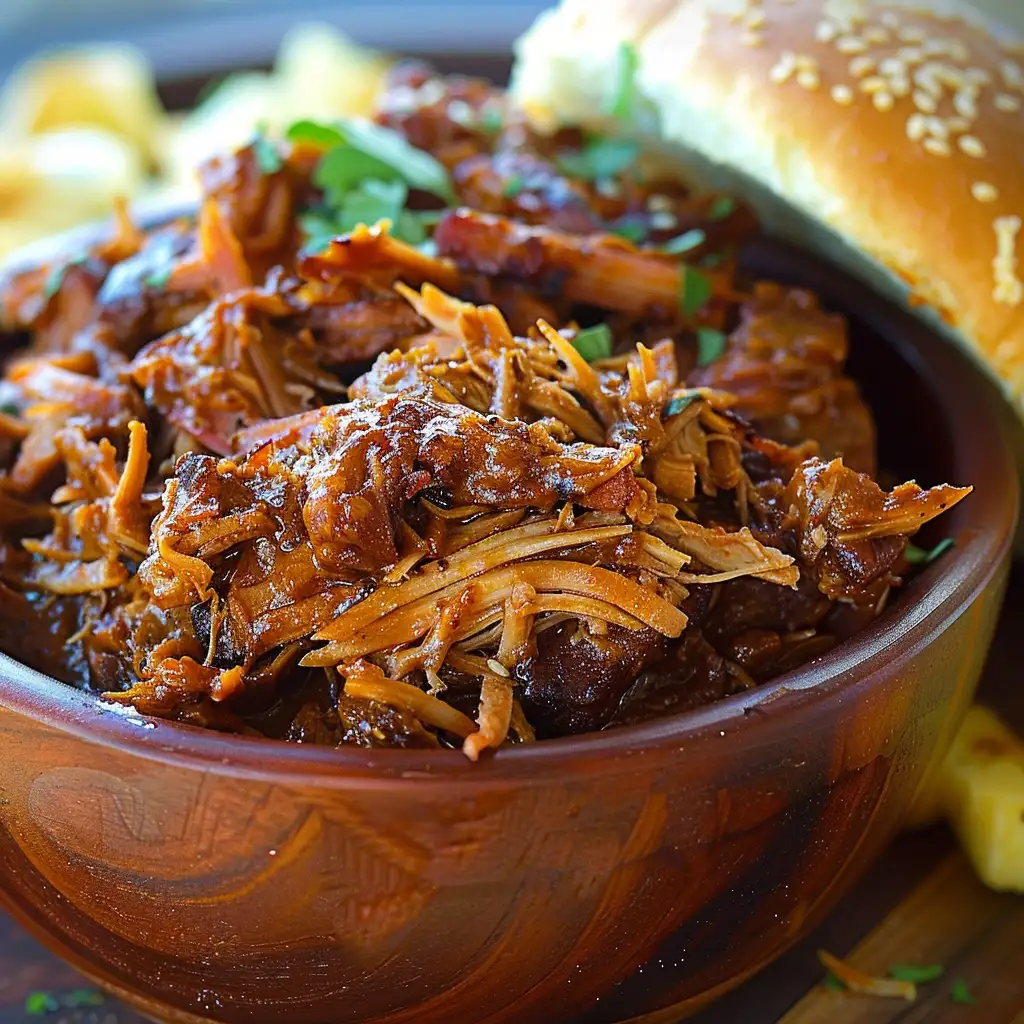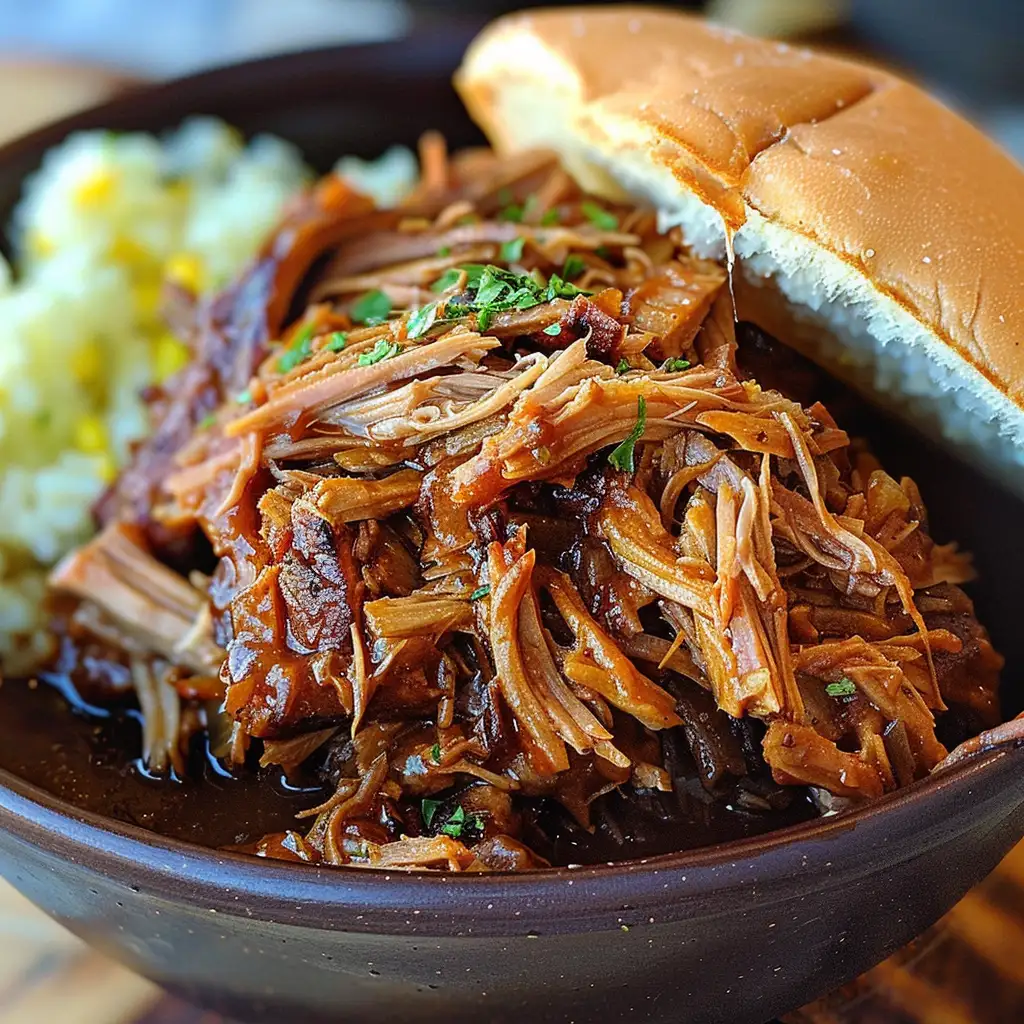Slow Cooker Texas Pulled Pork
Introduction
Slow cookers have revolutionized home cooking, offering a convenient way to prepare delicious meals with minimal effort. Among the myriad of dishes suited to this style of cooking, Texas Pulled Pork stands out for its robust flavors and simplicity. This dish captures the essence of traditional Texas BBQ without the need for a pitmaster’s watchful eye. In this article, we explore the savory world of Slow Cooker Texas Pulled Pork, emphasizing why it’s a favorite for both everyday meals and special occasions.
Choosing the Right Cut of Pork
The secret to mouthwatering Texas Pulled Pork begins with selecting the right cut of meat. Here’s why the pork shoulder, also known as Boston butt, is unparalleled for this recipe:
- Intrinsic Marbling: The natural fats within the pork shoulder melt during slow cooking, infusing the meat with moisture and flavor.
- Texture and Tenderness: Slow cooking transforms the tough muscle fibers into a tender, pull-apart delight.
If pork shoulder isn’t available, alternatives like pork loin can be used, though they may yield slightly less tender results. Regardless of the cut, quality is paramount. Opt for well-marbled meat to ensure a juicy, flavorful outcome. For a deeper dive into the origins of this cut, read more about why it’s called Boston butt.
Key Ingredients for Texas-Style Pulled Pork
The magic of Texas Pulled Pork lies not just in the meat, but also in the carefully selected blend of ingredients that create its signature flavor:
- Bone Broth: Adds depth and richness as the base of the cooking liquid.
- Prunes: Offer natural sweetness, reducing the need for added sugars.
- Apple Cider Vinegar: Introduces a tangy profile that tenderizes the pork and balances the sweetness.
Each ingredient plays a crucial role in crafting the dish’s complex flavor profile. The broth enriches, the prunes sweeten, and the vinegar cuts through with a necessary tang, ensuring a harmonious blend of tastes that are distinctly Texan. Discover more about the culinary uses of prunes in dishes like pulled pork baked potatoes, which showcase the versatility of this ingredient.
By understanding the function of these ingredients, home cooks can master the art of Texas-style pulled pork, turning a simple meal into a festive feast. Enjoy experimenting with these flavors and watch as this slow cooker classic becomes a household favorite.
Preparing the Pork and Seasoning
Preparing your pork shoulder for the slow cooker involves a few key steps that enhance the flavor and tenderness of your pulled pork:
- Trimming the Fat: Start by trimming off the excess fat from the pork shoulder, leaving just enough to keep the meat moist during cooking.
- Applying the Dry Rub: Combine spices such as smoked paprika, chipotle powder, garlic powder, onion powder, and salt. This dry rub adds a smoky, spicy layer of flavor that is quintessential to Texas-style barbecue.
- Marinating: For deeper flavor penetration, coat the pork with the dry rub and let it marinate in the refrigerator overnight. If short on time, even 30 minutes at room temperature can help the flavors to meld.
The spices used in the dry rub are crucial for achieving the authentic Texan flavor. Smoked paprika and chipotle powder give the meat its signature smoky taste, while onion and garlic powders add savory notes that are key to the dish’s depth of flavor.
Slow Cooking Process
Slow cooking is ideal for transforming tougher cuts of meat into tender, flavorful dishes. Here’s how to achieve the perfect Texas Pulled Pork:
- Setting Up Your Slow Cooker: Place the marinated pork in the slow cooker. Pour a mixture of bone broth, apple cider vinegar, and a dash of Worcestershire sauce over the meat to keep it moist and flavorful.
- Cooking Time and Temperature: Cook on low for 8 to 10 hours or on high for 5 to 6 hours. The long, slow cooking process allows the meat to become incredibly tender and infuses it with the rich flavors of the spices and liquids.
For additional insights into using bone broth in recipes, consider exploring its benefits and variations here.
Serving and Enjoying Texas Pulled Pork
Once your pulled pork is cooked to perfection, it’s time to serve and enjoy. Here are some creative ways to savor this delicious dish:
- Pulled Pork Sandwiches: Shred the pork and heap it onto a toasted bun. Top with coleslaw or pickles and a spoonful of BBQ sauce for a classic presentation.
- Pulled Pork Sliders: Perfect for parties, serve smaller portions on mini buns. Pair with a spicy or sweet BBQ sauce to complement the smoky meat.
- Creative Leftovers: Use leftover pulled pork in tacos, quesadillas, or even as a topping for nachos or baked potatoes.
For side dishes, consider these options to complete your meal:
- Coleslaw: Adds a crunchy, creamy contrast to the tender pork.
- Baked Beans: A sweet and savory side that pairs well with the richness of the pork.
- Cornbread: Offers a sweet, crumbly accompaniment that soaks up the flavorful juices.
Discover more about crafting the perfect side dishes for BBQ at Southern Living.
By following these steps and using these serving suggestions, you can turn a simple slow cooker recipe into a gourmet meal that captures the essence of Texas barbecue. Enjoy the process and the delicious results!

Comparing BBQ Styles: Texas vs. Carolina
When it comes to American BBQ, the regional variations highlight unique cooking styles and flavor preferences. Here’s a comparison between Texas and Carolina BBQ:
- Texas BBQ: Known for its use of beef, Texas BBQ features a dry rub and a slow cook approach that emphasizes the smoky flavor. Sauces tend to be thick, tomato-based, and can range from sweet to spicy.
- Carolina BBQ: Pork is the star in Carolina BBQ, especially pulled pork that is often flavored with a vinegar-based sauce, making it tangier. This style is distinguished by its lighter, more acidic sauces which help to cut through the fat of the pork.
These regional differences significantly influence the preparation and flavors of pulled pork. Texas-style focuses on the smokiness and richness of the sauce, while Carolina-style highlights the tanginess and acidity that complement the fattiness of the pork.
Storage and Reheating Tips
To ensure your pulled pork remains delicious and safe after initial preparation, follow these storage and reheating guidelines:
- Storage: Cool the pulled pork before refrigerating it in airtight containers. This helps to preserve the moisture and flavor.
- Reheating: Reheat only the amount needed to avoid multiple reheats. Use a stove, bringing the pork to a simmer and adding a bit of broth if needed to keep it moist.
For more tips on safely storing and reheating leftovers, check out this comprehensive guide at Southern Living.

FAQs
- Can you cook pulled pork in a slow cooker with frozen pork?
- It is not recommended to cook frozen pork in a slow cooker as it can lead to uneven cooking and potential food safety issues. Always thaw pork in the refrigerator before cooking.
- What’s the best liquid to cook pulled pork in?
- A mixture of chicken stock and apple cider vinegar offers a balance of flavor and acidity, enhancing the meat’s natural tastes without overpowering it.
- How long can you keep pulled pork warm in a slow cooker?
- Pulled pork can be kept warm for up to 2-3 hours in a slow cooker on the ‘keep warm’ setting. Ensure it stays above 140°F to prevent bacterial growth.
For additional insights into using apple cider vinegar in recipes, you might want to explore its various uses here.

